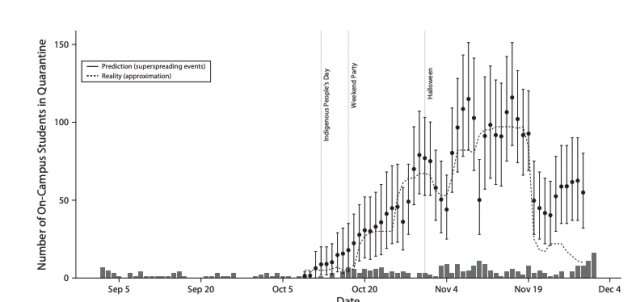Why is it sometimes best to keep things simple when deciding how to allocate pandemic resources?
When SARS-CoV-2, the virus that produces COVID-19, is so unpredictable, it’s impossible to plan ahead. However, there is now a simple approach for anticipating one of the resources needed to restrict COVID-19’s growth in communities.
Researchers at Boston University (BU) devised a real-time technique for forecasting COVID-19 quarantine needs 10 days in advance in congregate living environments.
Wenrui Li, a former doctoral student in Mathematics & Statistics, worked with Eric Kolaczyk, Director of the Hariri Institute and Professor of Mathematics & Statistics, Laura White, Professor of Biostatistics at the BU School of Public Health, and Laura White, Professor of Biostatistics at the BU School of Public Health, to develop a simple statistical model that incorporates readily available data, such as daily case counts and contact tracing details, and is informed by sensible experiences and The findings of the researchers were just published in The American Journal of Public Health (AJPH).
The first rush of COVID-19 cases that brought down Massachusetts caused considerable concern about sending students back to the BU campus, as it did for universities around the world. As a result, the BU administration supporting the COVID-19 reaction tasked academic specialists with determining the feasibility of testing, contact tracing, and quarantine measures to bring students back safely in the autumn over the summer of 2020.
«There was a lot of coordination across different departments and areas of the university, as well as university administration that was collecting and keeping the data,» White said.

The researchers assumed there were super-spreader events, like parties, on or near the holiday weekends noted in the figure. Their ten-day projections of on-campus quarantine counts closely matched the real trends on the BU campus.
However, some of the earlier predictions for quarantine and isolation turned out to be incorrect. Fortunately, BU set aside hundreds of beds in excess of what was required. «In establishing the number of quarantine and isolation beds, we found ourselves in new waters,» stated Peter Smokowski, VP of Auxiliary Services.
«However, Eric’s team’s modeling was really helpful in setting a benchmark number.» The researchers’ original model was designed to provide guidelines for safely returning students to campus, not precise predictions of the number of beds required.
In the fall, modeling experts Kolaczyk, White, and Li continued to collaborate on a more precise model for forecasting quarantine needs. The team’s new model integrates information from contact tracing on how student populations interact off and on campus, as well as data on daily positive case counts for students.
The algorithm also takes into account occasions when COVID-19 is more likely to spread, such as extended weekends or holidays. The team’s strategies for developing its model are both successful and easy.
«Even though the software is only five lines of code,» Kolaczyk explained, «it is built on a fairly principled strategy, based on standard conceptions of infected individuals arriving and local transmission.» Li is still pleasantly pleased by the model’s simplicity and efficiency. «Our model is basic, but it works,» Li explained.
In the future, a new SARS-CoV-2 strain or disease could emerge, and how resources like quarantine housing are allocated could make a huge impact on how quickly it spreads via crowded settings. The model developed by the researchers can be used in other situations when people in close quarters connect with that outside. This model could be used by correctional facilities, nursing homes, or military housing locations to forecast quarantine demands and distribute housing resources properly.
«The realization of how ubiquitous the need for quarantine space optimization is across the world drove us to transition this from a BU project to a publication,» Kolaczyk said. «Our model can be used as a predictive tool to allocate resources from a relatively milder baseline…rather than being reactive.»






Be the first to comment on "Why is it sometimes best to keep things simple when deciding how to allocate…"